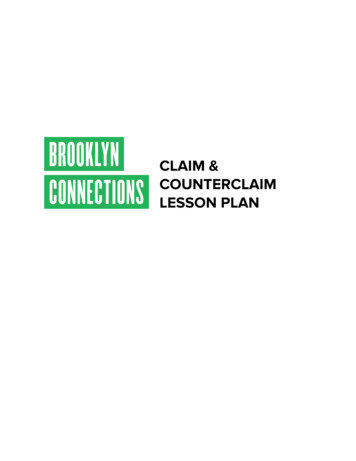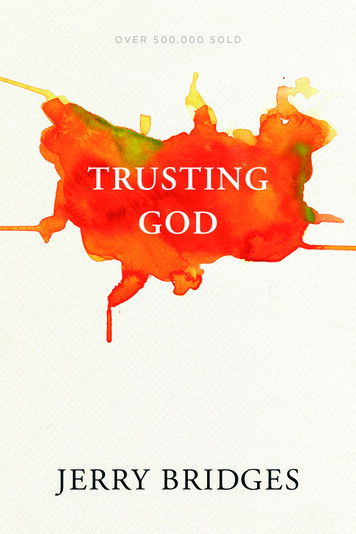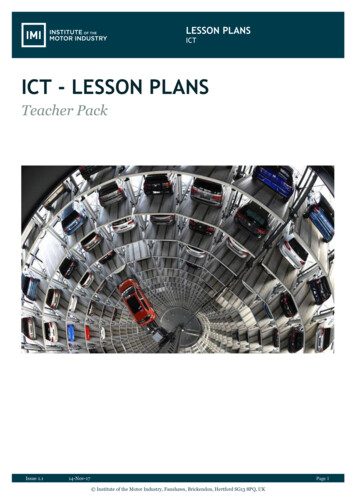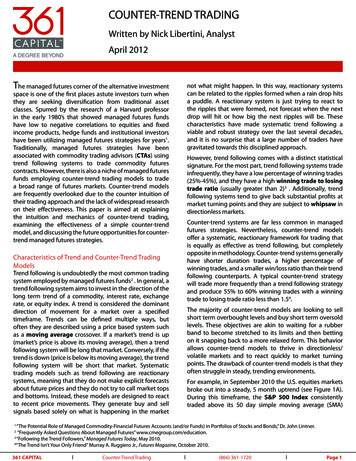
Transcription
CLAIM &COUNTERCLAIMLESSON PLAN
AIM:Students will use primary source documents to identify claims and counterclaims.OBJECTIVE:Students will: Learn how to define both claim and counterclaim Practice making strong claims and strong counterclaims Analyze informational texts Locate evidence Practice defending claims and evidence with solid reasoningMATERIALS:PROCEDURE: Claim and Counterclaim HandoutPrimary Source(s)Claim and Counterclaim prezi:http://prezi.com/pc2vof75xeum/?utm campaign share&utm medium copy&rc ex0share1. Warm-up:a. Ask students to define claimi. Claim: something you believe. Note: claims don’t have to be trueb. Ask students to define counterclaimi. Counterclaim: An opposing viewpoint; something said to offset someone else’sclaim. Note: a counterclaim is not necessarily the converse, simply a differentopinion. ie. Cars are the most important form of transportation vs. busses vs.airplanes vs. boats.2. Group Practice:a. Practice making claims using popular characters: Harry Potter vs. Katniss Everdeen,Jay-Z vs. Beyoncé, etc.i. Educator will try to maintain order, getting a clear claim and then soliciting a clearcounterclaim.ii. Encourage students to provide a reason for their claim; any reason will do,“Because Katniss is a girl” is an acceptable reason for this portion of the activity.b. Ask students: How do scholars support claims? Discuss the importance of evidencec. Return to original debate and ask students to think of ways they could support theirclaims with strong evidence:i. Jay-Z vs. Beyoncé: who has more awards?ii. Harry Potter vs. Katniss: which series made more money?3. Independent Practice:a. Present students with a primary source document that has a clear claim andcounterclaim - pro/con.i. The attached document is from the Girls High School Record, a studentnewspaper. Opinion columns in newspapers are helpful places to look.ii. You may also use multiple documents that discuss the same issue.b. Students will identify a claim and counterclaim. Students will locate evidence tosupport each claim.i. The Girls High School Record can be cut up into individual squares. Students willplace each response under the correct claim (pro/con) and then pull evidencefrom the text.d. Once students have located evidence for both claims, they will choose the claim theythink is the strongest and, along with two pieces of strong evidence, document it onthe front of their handout.e. Students must defend their evidence choice and present their reasoning. Reasoningis when students explain how and why their evidence supports their claim byproviding analysis, acknowledgement of connections between ideas, etc.CLAIM AND COUNTERCLAIM LESSON PLAN
4. Debatea. Ask a student to state their claim, their evidence, and their reasoning.CLAIM AND COUNTERCLAIM LESSON PLAN
b. Ask if any students disagree with that claim, can counter that evidence, or see a flawin the reasoning.c. Continue, exploring different ways students supported their claims.C.C.S.S. ADDRESSED:4th GradeCCSS.ELA-Literacy.RL.4.1 Refer to details and examples in a text when explaining what thetext says explicitly and when drawing inferences from the text.CCSS.ELA-Literacy.RI.4.6 Compare and contrast a firsthand and secondhand account of thesame event or topic; describe the differences in focus and the information provided.CCSS.ELA-Literacy.W.4.9 Draw evidence from literary or informational texts to supportanalysis, reflection, and research.CCSS.ELA-Literacy.SL.4.4 Report on a topic or text, tell a story, or recount an experience inan organized manner, using appropriate facts and relevant, descriptive details to supportmain ideas or themes; speak clearly at an understandable pace.5th GradeCCSS.ELA-Literacy.RL.5.1 Quote accurately from a text when explaining what the text saysexplicitly and when drawing inferences from the text.CCSS.ELA-Literacy.RI.5.6 Analyze multiple accounts of the same event or topic, notingimportant similarities and differences in the point of view they represent.CCSS.ELA-Literacy.W.5.9 Draw evidence from literary or informational texts to supportanalysis, reflection, and research.CCSS.ELA-Literacy.SL.5.4 Report on a topic or text or present an opinion, sequencing ideaslogically and using appropriate facts and relevant, descriptive details to support main ideasor themes; speak clearly at an understandable pace.6th GradeCCSS.ELA-Literacy.W.6.9 Draw evidence from literary or informational texts to supportanalysis, reflection, and research.CCSS.ELA-Literacy.SL.6.4 Present claims and findings, sequencing ideas logically and usingpertinent descriptions, facts, and details to accentuate main ideas or themes; useappropriate eye contact, adequate volume, and clear pronunciation.CCSS.ELA-Literacy.WHST.6-8.1a Introduce claim(s) about a topic or issue, acknowledge anddistinguish the claim(s) from alternate or opposing claims, and organize the reasons andevidence logically.CCSS.ELA-Literacy.WHST.6-8.1b Support claim(s) with logical reasoning and relevant,accurate data and evidence that demonstrate an understanding of the topic or text, usingcredible sources.7th GradeCCSS.ELA-Literacy.W.7.9 Draw evidence from literary or informational texts to supportanalysis, reflection, and research.CCSS.ELA-Literacy.SL.7.4 Present claims and findings, emphasizing salient points in afocused, coherent manner with pertinent descriptions, facts, details, and examples; useappropriate eye contact, adequate volume, and clear pronunciation.CCSS.ELA-Literacy.WHST.6-8.1a Introduce claim(s) about a topic or issue, acknowledge anddistinguish the claim(s) from alternate or opposing claims, and organize the reasons andevidence logically.CCSS.ELA-Literacy.WHST.6-8.1b Support claim(s) with logical reasoning and relevant,accurate data and evidence that demonstrate an understanding of the topic or text, usingcredible sources.CLAIM AND COUNTERCLAIM LESSON PLAN
8th GradeCSS.ELA-Literacy.W.8.9 Draw evidence from literary or informational texts to supportanalysis, reflection, and research.CCSS.ELA-Literacy.SL.8.4 Present claims and findings, emphasizing salient points in afocused, coherent manner with relevant evidence, sound valid reasoning, and well-chosendetails; use appropriate eye contact, adequate volume, and clear pronunciation.CCSS.ELA-Literacy.WHST.6-8.1a Introduce claim(s) about a topic or issue, acknowledge anddistinguish the claim(s) from alternate or opposing claims, and organize the reasons andevidence logically.CCSS.ELA-Literacy.WHST.6-8.1b Support claim(s) with logical reasoning and relevant,accurate data and evidence that demonstrate an understanding of the topic or text, usingcredible sources.9th – 10th GradesCCSS.ELA-Literacy.RL.9-10.1 Cite the textual evidence that most strongly supports ananalysis of what the text says explicitly as well as inferences drawn from the text.CCSS.ELA-Literacy.W.9-10.1 Write arguments to support claims in an analysis of substantivetopics or texts, using valid reasoning and relevant and sufficient evidenceCCSS.ELA-Literacy.W.9-10.1a Introduce precise claim(s), distinguish the claim(s) fromalternate or opposing claims, and create an organization that establishes clear relationshipsamong claim(s), counterclaims, reasons, and evidence.CCSS.ELA-Literacy.W.9-10.1b Develop claim(s) and counterclaims fairly, supplying evidencefor each while pointing out the strengths and limitations of both in a manner that anticipatesthe audience’s knowledge level and concerns.11th- 12th GradesCCSS.ELA-Literacy.RL.11-12.1 Cite strong and thorough textual evidence to support analysisof what the text says explicitly as well as inferences drawn from the text, includingdetermining where the text leaves matters uncertainCCSS.ELA-Literacy.W.11-12.1 Write arguments to support claims in an analysis of substantivetopics or texts, using valid reasoning and relevant and sufficient evidenceCCSS.ELA-Literacy.W.11-12.1a Introduce precise, knowledgeable claim(s), establish thesignificance of the claim(s), distinguish the claim(s) from alternate or opposing claims, andcreate an organization that logically sequences claim(s), counterclaims, reasons, andevidence.CCSS.ELA-Literacy.W.11-12.1b Develop claim(s) and counterclaims fairly and thoroughly,supplying the most relevant evidence for each while pointing out the strengths andlimitations of both in a manner that anticipates the audience’s knowledge level, concerns,values, and possible biases.CLAIM AND COUNTERCLAIM LESSON PLAN
CLAIM AND COUNTERCLAIM LESSON PLANCITATION: Kifferstein, Claire. “Inquiring Reporter.” Girls’ High Record. 9 March 1939. Print.
CLAIM AND COUNTERCLAIMLook at the article from Girls High Record. What is one claim you can identify?List two pieces of evidence in support of this claim:1.2.What counterclaim can you find?List two pieces of evidence in support of this counterclaim:1.2.CLAIM AND COUNTERCLAIM LESSON PLAN
CCSS.ELA-Literacy.SL.4.4 Report on a topic or text, tell a story, or recount an experience in an organized manner, using appropriate facts and relevant, descriptive details to support main ideas or themes; speak clearly at an understandable pace. 5th Grade CCSS.ELA-Literacy.RL.5.1 Quote accurately from a text when explaining what the text says










